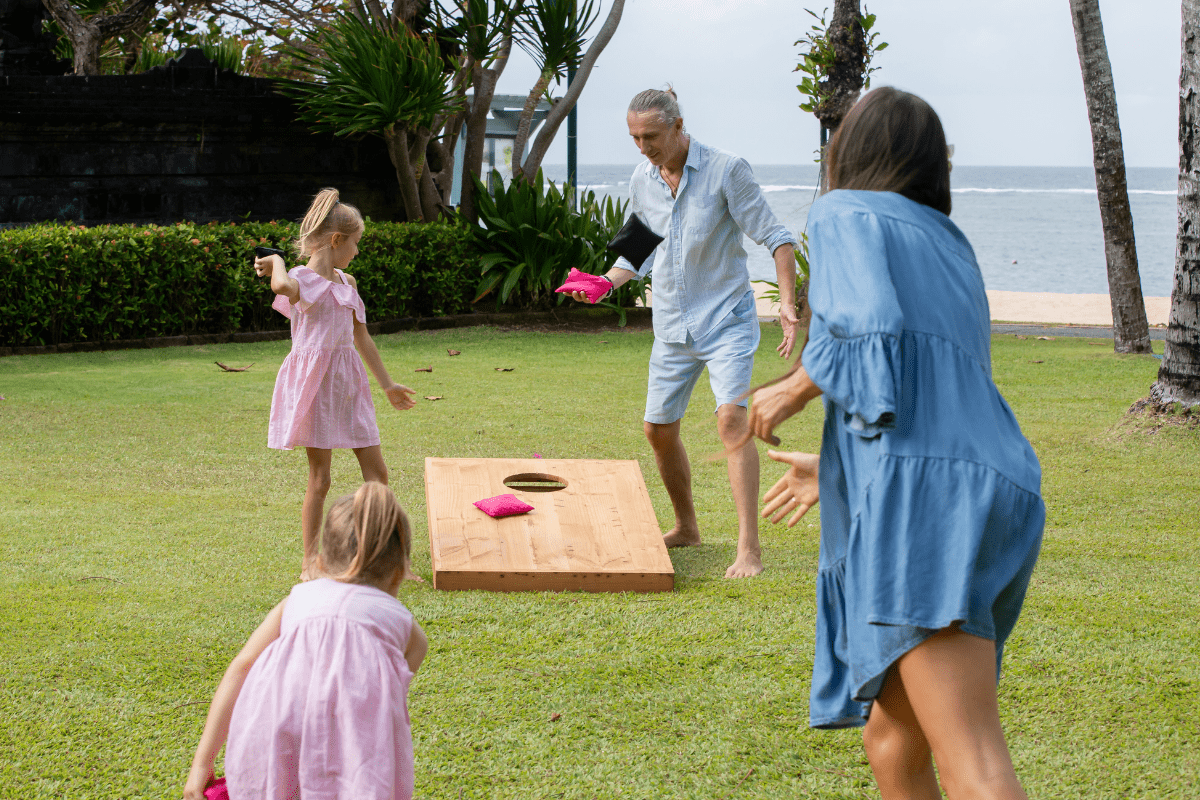The secret to transforming any outdoor gathering into an unforgettable experience lies in choosing games that genuinely engage everyone from toddlers to grandparents, creating those magical moments where four-year-olds high-five their great-grandparents.
What makes multigenerational games actually work
Let's be honest… finding activities that don't bore teenagers while still being safe for preschoolers feels impossible. But the best cross-generational games share a few key traits that make them winners for everyone involved.
The magic happens when games have flexible complexity, meaning you can dial the difficulty up or down depending on who's playing. Think of it like adjustable weights at the gym, but way more fun and with less grunting. Physical accessibility matters too because not everyone can sprint around like they're training for the Olympics.
According to family event experts, the winning formula includes simple rules everyone remembers, natural team mixing opportunities, safety-first design principles, roles for different ability levels, and built-in laughter guarantees. Basically, if your game makes everyone smile and nobody ends up in the emergency room, you're doing it right.
Quick setup games that need almost nothing
Sometimes the best games are the ones you can start in about thirty seconds with whatever you've got lying around. These are your go-to options when someone inevitably asks "what should we do now?" and you need something fast.
Musical statues with creative themes
Grab any portable speaker and you're halfway there. When the music plays, everyone dances like nobody's watching (spoiler alert: everyone's watching and it's hilarious). When it stops, freeze like a statue, but here's the twist… add themes like "freeze like your favorite animal" or "freeze in the most ridiculous pose possible."
For the little ones aged 3-5, pair them with a "freeze buddy" who can help them understand when to stop moving. School-age kids love being the DJ or adding movement challenges like dancing on one foot. Meanwhile, older adults can judge the silliest poses or help guide the younger children, giving them an important role without requiring Olympic-level athleticism.
The beauty of this game is that you literally cannot fail at it. Even if someone keeps dancing after the music stops, it just becomes funnier for everyone watching.
Color hunt relay races
This game turns your backyard into a treasure hunting ground using nothing but nature itself. Teams race to find objects matching whatever color you call out, and trust me, watching adults sprint around looking for "something purple" is entertainment gold.
Start with easy colors like green grass or brown sticks for the younger crowd. Kick it up a notch with specific shades like "sunset orange" or "ocean blue" for the competitive types. The real magic happens when you mix ages on teams, creating natural mentoring moments between generations.
Pro tip: avoid asking for "something black" unless you want to watch your family members frantically digging through their pockets for random objects. Trust me on this one.
Name that tune through the decades
Here's where different generations get to show off their musical knowledge and discover they actually know more songs in common than expected. Create mixed-age teams and play song snippets from different decades, awarding points for correctly identifying the song, artist, or decade.
Include everything from 1950s classics through today's hits, mixing genres like pop, rock, country, and R&B. Give bonus points when younger players nail an older song or when grandparents surprise everyone by recognizing current hits. Don't forget TV theme songs… they're surprisingly universal across age groups.
The best part is watching teenagers realize their grandparents actually had pretty good taste in music, and seeing grandparents discover that not all modern music sounds like noise.
Water games for those sweltering days
When the temperature climbs and everyone's looking a little wilted, water games become absolute lifesavers. These activities cool everyone down while ramping up the fun factor exponentially.
Water limbo with musical timing
Take classic limbo and add a garden hose for instant awesome. Instead of a pole, participants try to go under a stream of water without getting soaked (spoiler: everyone gets soaked and loves it). One person controls the hose height while music plays, changing the water level with the beat for added challenge.
Try reverse limbo where the goal is actually getting the most drenched, or partner limbo where two people go under together. Fair warning: this game tends to dissolve into gleeful water fights, so consider that a feature, not a bug.
The key is having someone trustworthy on hose duty. You don't want that one cousin who thinks it's hilarious to blast everyone at full pressure… unless that's exactly the vibe you're going for.
Sponge relay races
Set up buckets of water at a starting line and empty containers at the finish line about 20 feet away. Teams race to transfer water using only large sponges, squeezing them into the containers. It sounds simple until you realize how surprisingly difficult it is to keep water in a sponge while running.
Level the playing field by letting younger kids start closer to the finish line, while older players can carry multiple sponges for strategic advantage. You can declare winners based on either the first team to fill their container or whoever has the most water after a set time limit.
This game inevitably turns into everyone being completely soaked, which is perfect for hot days but maybe not ideal if you're planning indoor activities afterward.
Water balloon olympics
Create multiple stations for different water balloon events, but stock up on biodegradable balloons because regular balloons are terrible for the environment. Set up partner toss stations where teams start close together and step back after each successful catch, overhead relay lines where team members pass balloons down the line, and target practice areas with buckets of different sizes for varying point values.
Have teenagers help with balloon filling and station setup… they're surprisingly good at this and it gives them ownership in the activity. Keep towels handy and warn everyone to bring extra clothes because things get wonderfully messy.
Word of advice: fill way more balloons than you think you need. They break faster than you expect, and nothing kills the momentum like running out of ammunition mid-game.
Equipment-based games worth the investment
Sometimes spending a little money upfront creates games that become family traditions for years. These options require some equipment but deliver maximum entertainment value for the investment.
Strategic cornhole competitions
Cornhole has become the unofficial sport of backyard gatherings for good reason. Place boards 27 feet apart for official rules, but move them closer for younger players or smaller spaces. Teams of two take turns tossing bags at opposite boards, with bags through the hole scoring 3 points and bags on the board scoring 1 point.
Create tournament brackets with family draft teams where kids get to "draft" adults for their squads. Try fun variations like blindfolded rounds, non-dominant hand only, or backwards throwing to level the playing field. You can find DIY tutorials online if you're feeling crafty, or buy ready-made sets that'll last for decades.
The best part about cornhole is that it's equally entertaining whether you're terrible at it or surprisingly good. Either way, there's plenty of good-natured trash talking to go around.
Giant jenga with challenge blocks
Take regular Jenga and supersized it using a giant wooden block set or build your own with 2×4 lumber. The twist that makes this multigenerational magic? Write challenges on each block that players must complete when they pull it out.
Age-appropriate challenges work best. Kids get tasks like "Do your best animal impression" or "Name three red things." Teens might get "Text someone a genuine compliment" or "Do 10 jumping jacks." Adults could share a funny childhood memory or name all their cousins' birthdays.
This transforms a simple stacking game into storytelling time and family bonding rolled into one wobbly tower of fun. Plus, the suspense of whether the tower will fall adds just the right amount of drama.
Giant tic-tac-toe tournaments
Create a 9-square grid on the ground using rope or tape, making each square about 2 feet wide. Use large X and O markers like frisbees, hula hoops, or cardboard cutouts. Players toss their markers into squares instead of just placing them, adding a skill element that equalizes different ages.
Adjust throwing distances based on ability… young kids throw from 3 feet, most players from 6 feet, and competitive types from 10 feet. Try partner play where teammates alternate throws, creating natural collaboration opportunities between generations.
The throwing element means even tic-tac-toe strategy masters can be humbled by poor aim, which keeps things interesting for everyone involved.
High-energy games for active crowds
When you've got space to run and energy to burn, these games get everyone moving while building teamwork skills across age groups.
Capture the flag with role adaptations
Divide your space into two territories with a clear center line, giving each team a flag to defend while trying to capture the opposing team's flag. The classic rules work great, but smart adaptations make it multigenerational magic.
Create safety zones where younger kids can't be tagged, giving them confidence to participate actively. Assign older adults as flag guardians who defend the base but don't have to run around the entire field. Add strategy elements for teenagers by introducing different point values for different roles or special abilities for team captains.
This classic game requires at least six people and proper space division to work safely, so make sure you have adequate room and clear boundaries everyone understands. Nothing ruins the fun like confusion about where the territories end.
Obstacle course design principles
Building obstacle courses brings out everyone's creativity while providing physical challenges that scale naturally. Use equipment like hula hoops, pool noodles, cones, and rope to create stations that participants navigate through.
Key safety principles matter here. Keep obstacles under 12 inches high, use only soft materials like pool noodles, station adults at each obstacle, create multiple shorter courses instead of one marathon challenge, and let kids help design obstacles.
Including children in creating obstacles increases their engagement and investment in the activity, while giving them ownership over the experience. Plus, kids come up with wonderfully creative (and sometimes ridiculous) challenges that adults would never think of.
Ultimate frisbee lite version
Set up a field with end zones about 50 yards apart (adjustable based on your space), and teams advance the frisbee down the field by throwing to teammates. Score by catching in the end zone, but modify the rules to accommodate different abilities.
Implement a no-running rule for older adults or those with mobility limitations. Shorten the field distance as needed and consciously balance athletic abilities across teams. The goal is inclusion and fun, not recreating college-level competition.
Remember, frisbee throwing is harder than it looks, so expect some wild throws and lots of laughter as people chase discs into neighboring yards.
Multi-level scavenger hunts that engage everyone
Scavenger hunts work brilliantly across generations when you create tiered challenges that let everyone contribute their strengths while learning from each other.
Design three difficulty levels that teams tackle together. Level 1 for ages 3-7 includes simple tasks like "find something red" or "find something that makes noise." Level 2 for ages 8-15 adds interactive elements like "take a team selfie with a stranger" or "find something from each season." Level 3 for ages 16+ incorporates complex challenges like "answer three pieces of family trivia" or "demonstrate a skill you learned as a child."
The magic happens when mixed-age teams work together, with older members helping younger ones understand clues while younger participants spot things adults might miss. Everyone contributes their unique perspective and abilities.
Create printable lists ahead of time, but be prepared to modify on the fly based on your location and what's actually available to find.
Essential success strategies that actually work
Planning great multigenerational games isn't just about picking activities… it's about creating an environment where everyone feels included and valued.
Equipment and budget considerations
Start with basic essentials that work across multiple games: one quality frisbee, soft rubber ball, 50 feet of rope, sidewalk chalk, large bucket, and portable speaker. These six items can power dozens of different activities.
Budget-friendly alternatives work just as well as expensive equipment. Use milk jugs as cones, towels as flags, and cardboard for game boards. The goal is fun, not impressing anyone with fancy gear. Always keep a basic first aid kit, plenty of water, and some shade options available.
Honestly, some of the most memorable games happen with completely improvised equipment. That time we used someone's flip-flops as frisbees? Still gets brought up at every family gathering.
Smart team formation strategies
How you create teams determines whether your games succeed or become awkward disasters. Try the draft system where captains alternate picking players of different ages, family mixing that starts with family groups then mixes for variety, regular rotation that changes teams every few games, and role assignments that give everyone specific jobs like scorekeeper or equipment manager.
Celebrate effort and creativity over pure winning. Create award categories like "Best Sportsmanship," "Most Creative Strategy," or "Biggest Smile" so everyone gets recognized for something positive.
The secret is making sure nobody feels picked last or left out. When in doubt, just randomly assign teams… it removes any hurt feelings and often creates surprisingly balanced groups.
Safety and accessibility that makes sense
Good games accommodate different physical abilities without making anyone feel excluded or singled out. Always ask about limitations before starting, but do it casually during setup rather than making formal announcements that embarrass people.
Build multiple participation levels into every game. If someone can't run, they can be a coach, judge, or equipment manager. If mobility is limited, modify distances or create stationary roles that are still integral to the game's success.
Research shows that outdoor activities improve physical health in children and enhance emotional and physical health in older adults, while family time helps everyone feel more confident and teaches important skills like problem-solving and communication.
Keep sun protection top of mind with regular sunscreen reminders, hat encouragement, and scheduled water breaks. Know where the nearest medical facility is located, and designate one responsible adult as the safety point person for each activity.
Safety doesn't mean being overly cautious to the point where fun disappears. It just means being smart about preventing easily avoidable injuries.
Creating memories that last beyond the games
The real goal isn't finding the perfect game… it's creating an atmosphere where play brings people together naturally. When you see three generations working together to complete a scavenger hunt or laughing as they get soaked in water limbo, you know you've succeeded in building something special.
Designate someone as the unofficial photographer to capture spontaneous moments of joy, teamwork, and surprise. End each gathering with a group photo and ask everyone to share their favorite moment from the day. These simple traditions often become the memories people talk about for years.
Remember that the best outdoor games for all ages aren't just entertainment… they're bridge-builders between generations, memory-makers, and proof that play truly is timeless. So grab whatever equipment you can find, gather your people, and get ready to discover that the secret to bringing everyone together might just be a simple game of water balloon toss or giant tic-tac-toe.
The games that flop spectacularly often become the funniest stories later, so don't stress too much about everything going perfectly. Sometimes the best memories come from the moments when everything goes hilariously wrong.





